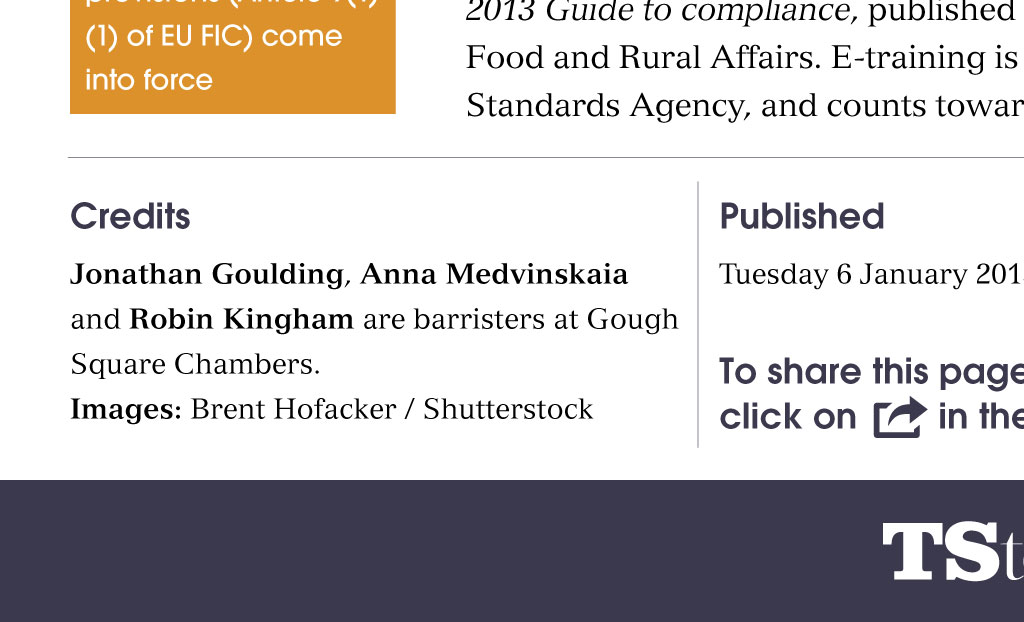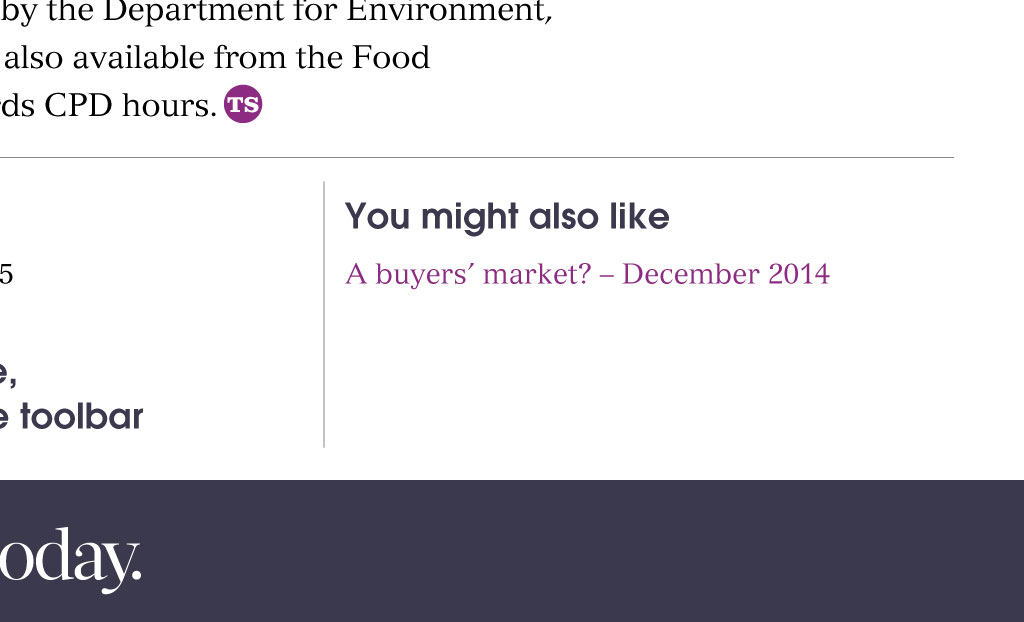




























, "25":"Legal In this feature l allergens l labelling requirements l Improvement Notices New FIRs in a nutshell As of 13 December, new rules on food information and labelling came into effect. Jonathan Goulding, Anna Medvinskaia and Robin Kingham present the changes T he Food Information Regulations 2014 (FIRs) came into force on 13 December 2014. FIRs implement the EU Food Information for Consumers Regulation 1169/2011 (EU FIC). These provisions represent a radical departure from the previous law, and cover all food information provided to consumers not just to information detailed on labels. The FIRs apply to food business operators at all stages of the supply chain. However, products that are placed on the market or labelled before 13 December are permitted to be sold, regardless of how long this takes. This will be particularly relevant to products with a long shelf life, such as frozen and tinned foods. As a result, old and new labelling will co-exist on store shelves for several years. A very significant change is the manner in which allergen and nutritional information is presented to consumers. The FIRs consolidate previous legislation, change the way that information appears on labels, and create obligations in respect of food sold loose and in restaurants and catering establishments. Further, the new regime provides for a different approach to enforcement of breaches of labelling and information requirements, with the emphasis on the use of improvement notices rather than prosecution. Key changes The FIRs revoke and replace the Food Labelling Regulations 1996 (FLRs). While they keep many of the old mandatory labelling requirements, FIRs introduce a number of changes: l Information about allergens will now have to be provided for non-prepacked food, including food served in catering establishments l Mandatory country-of-origin labelling will be extended beyond beef, to include pork, lamb, goat These provisions and poultry represent a radical l From December 2013 nutritional labelling will departure from the be compulsory for all foods, not only where a previous law, and cover all nutritional claim is made food information provided to l Food sold beyond its use-by date will be consumers not just to automatically deemed unsafe, even if from a information detailed on labels microbiological point of view, it would be fit for human consumption l A general requirement of fair information practices is imposed, including a requirement that food information shall not be misleading, and must be clear and easy for the consumer to understand l Food labelling requirements including font size and presentation areprescribed l Frozen meat must record the date of (first) freezing l The list of mandatory particulars for food labelling contained in the old Food Labelling Regulations 1996 has been expanded l Foods that are treated with ionising radiation must be labelled with the words irradiated or treated with ionising radiation l Where the durability of food has been extended by using packaging gases, the food must be labelled packaged in a protective atmosphere Allergen labelling A LLERGENS The 14 allergens covered by the FIRs are: l Cereals containing gluten l Crustaceans l Eggs l Fish l Peanuts l Soybeans l Milk l Nuts l Celery l Mustard l Sesame seeds l Sulphur dioxide and sulphites of more than 10mg/ kg or 10mg/l in terms of the total SO2 l Lupin l Molluscs One of the biggest changes under the FIRs is over allergen labelling requirements. The new rules cover: mandatory labelling of 14 specified allergens; a minimum font size for labelling; a mandatory nutritional declaration; and clearer indication of allergens and country of origin. Consumers will need to be informed if a food contains one of these allergens, or if a product is made from one of them. On pre-packed food these allergens will have to be emphasised in the ingredients list, using formatting such as bold, italics, underlining or colour. The use of allergy boxes that repeat mandatory ingredients information such as contains nuts is no longer allowed, but explanatory boxes, such as for allergen information, please see ingredients in bold, are permitted. It is also no longer acceptable to state that foods may contain allergens, or for a food business operator to deny knowledge of whether or not a food contains allergens. In relation to non-pre-packed foods, allergen information may be communicated on a menu, a chalkboard, or a prepared allergy folder. It must be clear and easily visible, and not hidden away. It is also permissible for food businesses to communicate allergen information about non-pre-packed food verbally to consumers but, if they do so, the business must have a sign informing consumers that they can ask staff for details of allergens. In this situation, food businesses will also need to be able to prove that they keep a written list of allergens available for reference by members of staff. Enforcement Before taking any enforcement action, enforcement officers need to ascertain whether a food business has a registered partnership with a Primary Authority. If it does, the enforcing officer must discuss any proposed enforcement action with the Primary Authority. Similarly, Home Authority arrangements should be taken into account before taking enforcement action. If a decision to enforce is made, the officer should consider the appropriate sanction. FIRs emphasise a scaled approach, with a hierarchy of enforcement options. For most breaches of FIRs, the only appropriate action will be to issue an Improvement Notice under regulation 12 of FIRs. The introduction of Improvement Notices as the first stop for enforcement gives officers a formal mechanism for highlighting noncompliance without the need for criminal proceedings. It also allows officers to give guidance to food businesses, so that they may avoid ending up in court in the future. To serve an Improvement Notice, an officer must have reasonable grounds for believing that a person is failing to comply with a provision of EU FIC. The notice must state: l The officers grounds for believing that the person is failing to comply with FIRs, with specific reference to their food business and which practice is at fault l Which of the provisions listed in regulation 12 of FIRs has been breached l What measures need to be taken to maintain compliance with the provision l The date by which the measures must be put in place l Details of the right of appeal An enforcement officer may suggest a broad range of measures to ensure compliance with FIRs. For example, the food business operator may be required to remove products from sale until the necessary measures have been put in place. Alternatively, an Improvement Notice may direct over labelling, over stickering, or replacement of the product label with a corrected version. Criminal enforcement remains possible where businesses fail to make the necessary changes when required to do so under the terms of an Improvement Notice. Failure to comply with an Improvement Notice is a summary offence, currently punishable with a fine of up to 5,000. The use of Improvement Notices The new rules cover: as a first stop for enforcing FIRs is likely to mean mandatory labelling of thatcriminal sanctions will largely be reserved for 14 specified allergens; cases when food business operators do not comply a minimum font size for with notices. labelling; a mandatory However, where breaches of FIRs concern foodnutritional declaration; and safety issues, or pose a real risk to consumer health, clearer indication of allergens there are provisions for immediate enforcement by and country of origin prosecution. If food is sold beyond its use-by date, this will create an offence of selling unsafe food under the Food Safety and Hygiene (England) Regulations 2013. Failure to comply with the new allergen labelling requirements will be an offence under the FIRs. Where a food business sells food beyond its use-by date, or fails to implement the new allergen requirements, enforcement officers will have the option of either issuing an Improvement Notice or prosecuting. The route taken will depend on the seriousness and circumstances of the offending in the particular case. Regulation 10(1) of FIRs creates the summary offence of failing to comply with various food allergen labelling provisions set out in EU FIC. The maximum fine on conviction for such an offence is currently 5,000. It should be noted that section 85 of the Legal Aid, Sentencing and Punishment of Offenders Act 2012 provides for the statutory maximum of 5,000 for such offences to be increased to an unlimited fine. Presently, no date has been set for implementation of this radical sentencing provision. Other provisions FIRs allow for certain derogations from EU FIC. First, milk packaged in reusable glass bottles does not have to comply with labelling requirements. Second, British minced meat does not have to comply with EU compositional requirements. However, British mince that does not comply with these requirements will have to carry a special mark and state For UK market. DATES TO REMEMBER 15 August 2014 derogation relating to minced meat came into force 13 December 2014 most provisions of FIR came into force 13 December 2016 mandatory nutrition declaration provisions (Article 9(1) (1) of EU FIC) come into force Conclusion These are far-reaching new provisions. By now, many enforcement officers will have become conversant with the guidance provided by the Food Standards and Labelling Focus Group on the enforcement of FIRs. Those enforcement officers will no doubt seek to ensure compliance by way of informal action and prudent use of Improvement Notices prosecution being an unwanted, and seldom used, last resort! Only time will tell if the aim set out in Recital 9 of EU FIC will come to pass, namely that the new regulation will: Serve the interests of the internal market by simplifying the law, ensuring legal certainty and reducing [the] administrative burden, and benefit citizens by requiring clear, comprehensible and legible labelling of foods. Further information may be found in the Food Information Regulations 2013 Guide to compliance, published by the Department for Environment, Food and Rural Affairs. E-training is also available from the Food Standards Agency, and counts towards CPD hours. Credits Published You might also like Jonathan Goulding, Anna Medvinskaia Tuesday 6 January 2015 A buyers market? December 2014 and Robin Kingham are barristers at Gough Square Chambers. Images: Brent Hofacker / Shutterstock To share this page, click on in the toolbar "